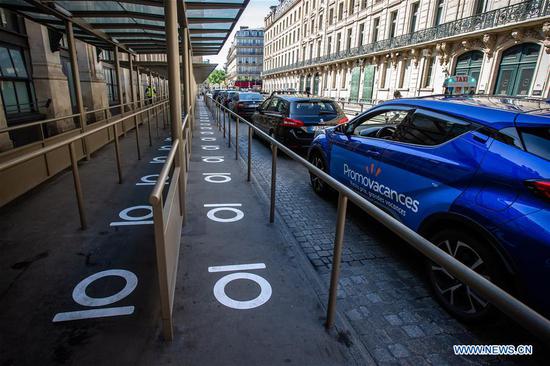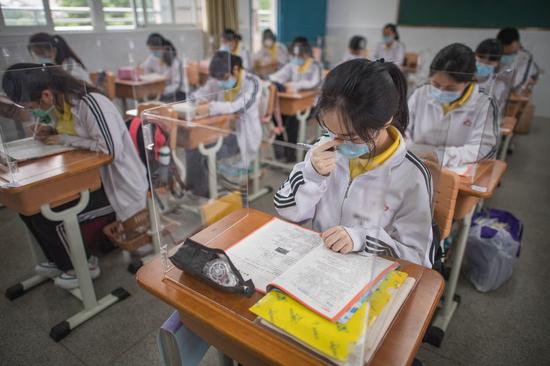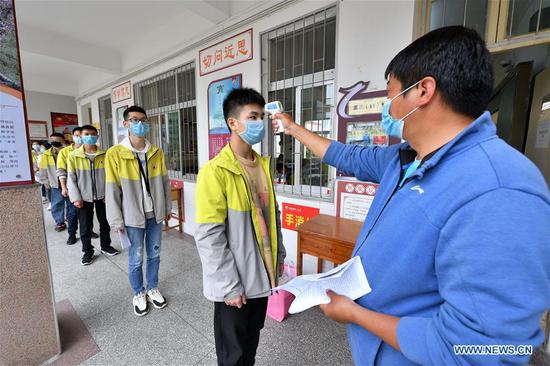New data showed that more than 33 million Americans have filed for jobless claims as COVID-19 continues to ravage economy, indicating the scope of damage to the labor market, while suggesting the historic wave of layoffs seems to be receding.
In the week ending May 2, the number of Americans filing for unemployment benefits decreased by 677,000 from the prior week to 3,169,000, the fifth weekly decline in a row, the U.S. Bureau of Labor Statistics (BLS) reported on Thursday.
The breadth of job losses is "stunning," Diane Swonk, chief economist at Grant Thornton, a major accounting firm, wrote in a recent blog. "They spanned virtually every industry and income category."
"Hiring screeched to a virtual halt," Swonk said. "Posting for new jobs on all the major job websites plummeted between 30 percent and 40 percent in March and April."
As COVID-19 shutdowns rippled through the workforce, initial jobless claims spiked by 3 million to reach a record 3.3 million in the week ending March 21, then doubled to reach a record 6.87 million in the week ending March 28.
After that, figures have been declining, though still at historical high. Initial jobless claims totaled 6.62 million in the week ending April 4, fell to 5.2 million in the week ending April 11, dropped to 4.4 million in the week ending April 18, and then declined to 3.8 million in the week ending April 25.
The new BLS report also showed that the four-week moving average, a method to iron out data volatility, decreased by 861,500 to reach 4.2 million.
Michael Hicks, director of the Center for Business and Economic Research at Ball State University in Indiana, recently told Xinhua that the jobless claims data points to "a deceleration of the huge losses from early April."
"The slowing losses indicate the bulk of job losses may be behind us," Hicks said. "As the economy begins to re-open, these losses will continue to slow."
Dozens of states have rolled out reopening plans in late April, with Georgia, Oklahoma, South Carolina, Tennessee and Texas among the first to allow certain nonessential businesses to resume operations.
As the U.S. economy witnesses its biggest slump since the global financial crisis, with massive job losses within weeks, the potential economic recovery following reopening could be welcoming news for many.
White House economic advisor Kevin Hassett recently told Fox News that every U.S. state will mostly reopen by the end of May, and most forecasters predict an economic rebound in the second half of the year.
According to a recent projection from the Wharton School of the University of Pennsylvania, partially reopening would increase GDP on June 30 by 1 percent year-on-year, to a 10.7 percent contraction. About 4.4 million jobs would be saved, although a total of 14.0 million jobs still will be lost between May 1 and June 30.
Fully reopening would boost GDP on June 30 by about 1.5 percentage points year-on-year compared with not reopening, the model showed. Almost all net job losses between May 1 and June 30, over 18 million, would be avoided.
The potential economic recovery following the reopening, however, doesn't come without a price. According to the Wharton model, partially reopening would cause 45,000 additional deaths by June 30 relative to not reopening. Fully reopening would lead to an additional 233,000 deaths.
"The evidence strongly backs the aggressive initial shelter-in-place orders," Hicks told Xinhua. "However, as we learn more about the disease, easing some of those restrictions seems wise."
Hicks also warned that a second wave of infections would be "very damaging to the economy."
The new jobless claim figure came one day after payroll data company Automatic Data Processing (ADP) reported that private companies in the United States shed around 20.2 million jobs in April amid COVID-19 fallout.
The advance seasonally adjusted insured unemployment rate was 15.1 percent for the week ending April 25, an increase of 2.9 percentage points from the previous week's unrevised rate, the BLS report showed.
The U.S. unemployment rate for April, to be released on Friday, is expected to rise to 16.1 percent, up from 4.4 percent in March, according to economists recently surveyed by The Wall Street Journal.
Michael Horrigan, president of the W.E. Upjohn Institute for Employment Research, wrote in an analysis that unemployment rate could surpass 20 percent in April, with the assumption that all individuals who lost their jobs between March 15 (just after the March reference week) and April 18 (the end of the April reference week) are classified as unemployed in April.
A nearly perfect proxy for this is the total number of initial jobless claims for each of the intervening weeks, which is 26.5 million, Horrigan noted.
"Assuming no decline in the size of the labor force from March to April (162.9 million) and that the 7.14 million unemployed in March remain unemployed in April, this yields an implied unemployment rate of 20.6 percent," he said.


















































